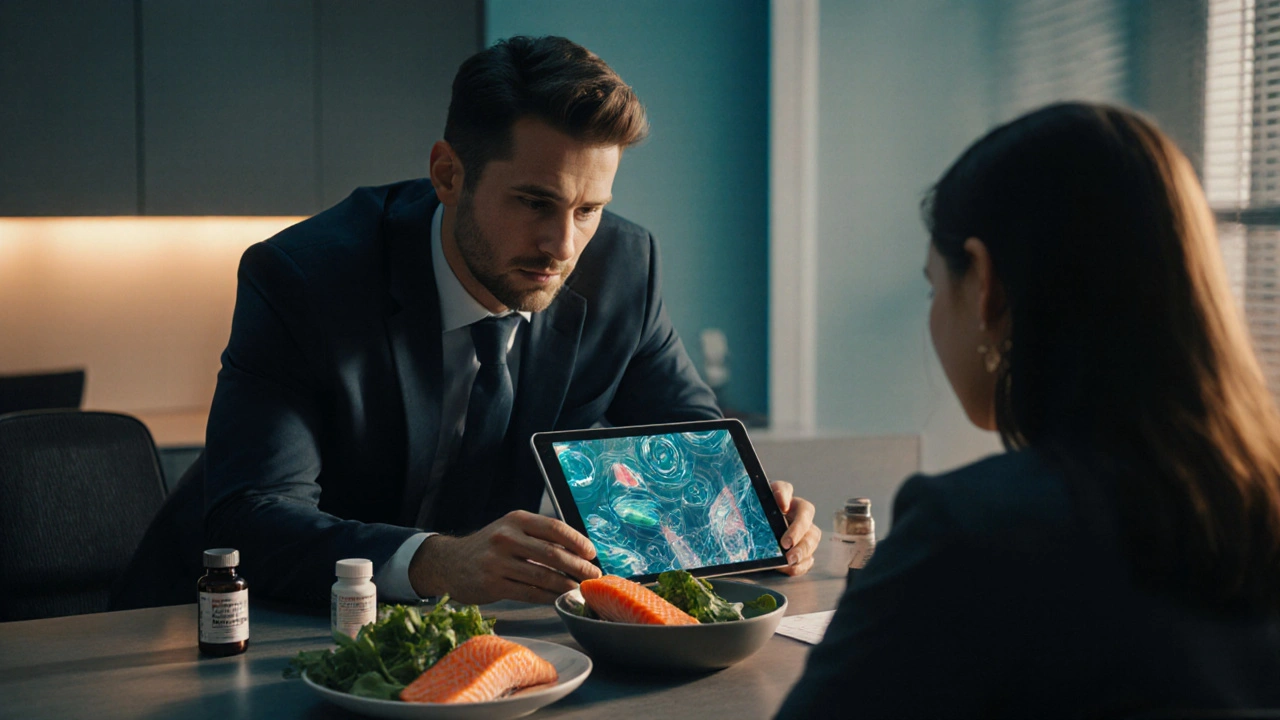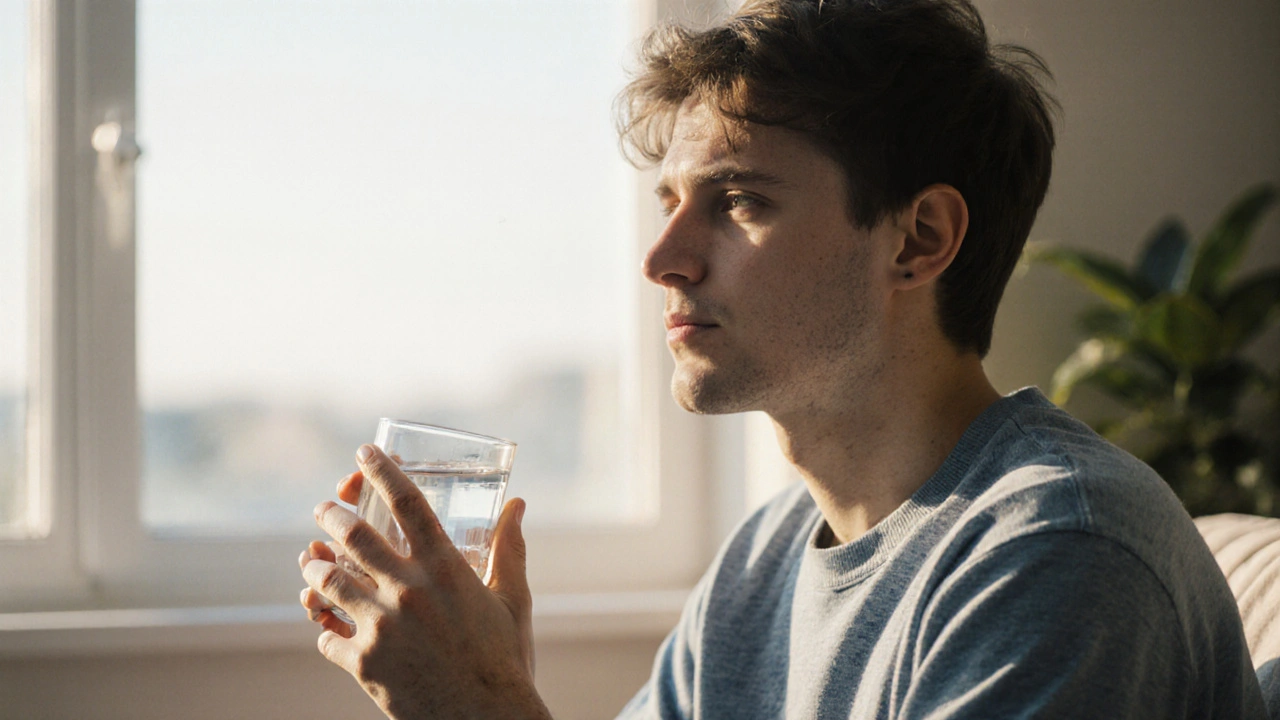Vitamin Deficiency Test Selector
Select your symptoms to identify the most appropriate vitamin deficiency tests based on clinical guidelines. This tool helps you discuss targeted testing with your healthcare provider.
Symptom Assessment
Select all symptoms you're experiencing:
Recommended Tests
Based on your symptoms: We recommend these tests:
- Comprehensive Micronutrient Panel
- Blood Serum Vitamin D Test
- Red Blood Cell (RBC) Vitamin B12 Test
Why these tests? Your symptoms suggest multiple possible deficiencies. This combination provides a complete picture to identify specific deficiencies without unnecessary testing.
Key Preparation Steps
- 8-hour fasting required
- Review medications with your provider
- Best done in late winter/early spring for vitamin D
Key Takeaways
- Blood serum testing is the gold‑standard for most vitamin deficiencies.
- Micronutrient panels give a broad picture of 30+ nutrients in one draw.
- Urine and hair analyses are useful for fat‑soluble vitamins and long‑term trends.
- Proper preparation-fasting, medication review, timing-improves accuracy.
- Interpret results with reference ranges and a qualified health professional.
Wondering why you keep feeling sluggish, getting frequent colds, or noticing brittle nails? Those could be clues that you’re low on one or more essential vitamins. The good news is that modern labs can pinpoint the shortage with a few simple tests. Below is a step‑by‑step guide that shows you which tests to order, how to prepare, and what the numbers really mean.
Vitamin deficiency is a condition where the body’s stores of a specific vitamin drop below the level needed for normal physiological function. Common culprits include vitamin D, B12, iron‑related vitamins, and the fat‑soluble vitamins A, E, and K. Deficiencies can arise from poor diet, malabsorption, medication side‑effects, or chronic illnesses.
Why Testing Matters
Symptoms are often vague-fatigue, mood swings, hair loss-so guessing can lead to unnecessary supplements that might cause toxicity. A targeted test tells you exactly which vitamin is low, how low it is, and whether a short‑term boost or a longer‑term dietary change is needed.
Typical Symptoms That Prompt Testing
- Persistent fatigue despite adequate sleep
- Unexplained muscle cramps or tingling
- Frequent infections or slow wound healing
- Dry skin, hair loss, or brittle nails
- Mood changes, irritability, or brain fog
If you notice several of these, it’s worth talking to a clinician about lab work.

Core Tests to Diagnose a Vitamin Deficiency
Below are the most reliable tests, grouped by the type of sample they require.
1. Blood Serum Test
Serum vitamin D test measures the concentration of 25‑hydroxy‑vitamin D in the blood, the accepted marker for overall vitamin D status. It is the vitamin deficiency test most doctors order first. A simple venous draw, usually after an overnight fast, provides a clear picture of both fat‑soluble and water‑soluble vitamins.
2. Micronutrient Panel
Micronutrient panel is a comprehensive assay that evaluates 30+ vitamins, minerals, and antioxidants from a single blood sample. It uses liquid chromatography or mass spectrometry to deliver precise levels for B‑complex vitamins, vitamin C, zinc, magnesium, and more. This is ideal when you suspect multiple deficiencies or want a baseline before a major lifestyle change.
3. Urine Test (24‑Hour Collection)
Urine vitamin C test captures how much vitamin C is being excreted over 24hours. High excretion can indicate excess intake, while low levels suggest deficiency, especially when dietary intake is known. It’s also used for vitamins B6 and B12 metabolites.
4. Hair Mineral Analysis
Hair analysis evaluates trace minerals and certain fat‑soluble vitamins (like vitamin A) that deposit in hair shafts over weeks to months. It’s useful for tracking long‑term trends, especially for people on restrictive diets.
5. Red Blood Cell (RBC) Vitamin Levels
Some labs offer RBC folate or RBC B12 tests. These reflect the vitamin content inside cells, providing a more stable picture than serum levels, which can fluctuate after a recent meal.
How to Prepare for Each Test
- Fasting: Most serum and micronutrient panels require an 8‑hour fast to avoid post‑prandial spikes.
- Medication Review: Certain drugs (e.g., anticonvulsants, proton‑pump inhibitors) affect vitamin absorption. Tell the lab technician.
- Hydration: For urine collections, drink a normal amount of water; over‑hydration can dilute results.
- Timing: Vitamin D testing is best in late winter or early spring, when levels naturally dip.
- Sample Size: Hair analysis needs about 50mg of hair (a small lock). Avoid hair products for 48hours before collection.
Interpreting the Results
Every lab provides reference ranges based on age, sex, and sometimes ethnicity. Here’s what to look for:
- Below Reference: Indicates a true deficiency; discuss supplementation and dietary sources.
- Within Range but Low‑Normal: May still cause symptoms in sensitive individuals; lifestyle tweaks can help.
- Above Upper Limit: Risk of toxicity, especially for fat‑soluble vitamins; cut back on fortified foods or high‑dose supplements.
Always have a qualified health professional contextualize the numbers. They’ll consider your medical history, medications, and any existing conditions.
When to Seek Professional Guidance
If any of the following apply, book an appointment:
- Severe or rapidly worsening symptoms
- Pregnancy, breastfeeding, or chronic disease (e.g., celiac, Crohn’s)
- Recent major surgery or hospitalization
- Long‑term use of medications known to affect vitamin metabolism
A registered dietitian or a physician specializing in nutrition can interpret complex panels and design a personalized plan.

Testing Checklist
- Identify symptoms and note frequency
- Choose the appropriate test(s) based on suspected vitamin
- Schedule fasting blood draw or 24‑hour urine collection
- Gather medication list and recent dietary changes
- Bring the lab requisition and insurance information (if applicable)
- Review results with a qualified clinician within 2weeks
- Adjust diet, supplementation, or lifestyle as advised
Comparison of Common Vitamin Tests
| Test | Sample | What It Measures | Pros | Cons |
|---|---|---|---|---|
| Serum vitamin D (25‑OH) | Blood (fasting) | Vitamin D status | Gold‑standard, quick turnaround | May miss intracellular deficiency |
| Micronutrient panel | Blood (fasting) | 30+ vitamins/minerals | Broad view, detects multiple deficiencies | Higher cost, longer processing |
| 24‑hour urine vitamin C | Urine (full collection) | Vitamin C excretion | Good for assessing excess intake | Requires strict collection protocol |
| Hair mineral analysis | Hair shaft | Long‑term trace mineral & fat‑soluble vitamin levels | Reflects weeks‑month trends | Potential external contamination, less standardization |
| RBC B12 / Folate | Blood (RBC) | Cellular vitamin B12 / folate | More stable than serum | More invasive, slightly higher cost |
Next Steps After Getting Your Results
- Schedule a follow‑up with your clinician within a week of receiving the report.
- Ask for a clear action plan: specific foods, supplement dosage, and duration.
- Implement dietary changes first-leafy greens for vitamin K, oily fish for D, lean meat for B12.
- Re‑test after 8‑12 weeks if a high‑dose supplement was prescribed, to verify correction.
- Track symptoms in a journal; improvement often mirrors rising nutrient levels.
Frequently Asked Questions
Which vitamin deficiency is most common in Australia?
Vitamin D deficiency tops the list, especially during the winter months when sun exposure drops below the needed threshold for skin synthesis.
Can I test for vitamin deficiency at home?
Yes, several labs now offer mail‑in kits for blood spot or dried urine collection. Accuracy can be slightly lower than a professional phlebotomy draw, so discuss with your doctor.
How long does it take to see results after supplementation?
Water‑soluble vitamins (B‑complex, C) often improve within a few weeks. Fat‑soluble vitamins (D, A, E, K) may need 2‑3 months of consistent intake to raise blood levels.
Do multivitamins cover all possible deficiencies?
Not always. Multivitamins contain average doses that may be insufficient for severe deficiencies. Targeted testing lets you address the exact nutrient that’s low.
Is a hair analysis reliable for vitamin testing?
Hair analysis is useful for trends over time, but results can be affected by hair treatments, external contamination, and lab variability. Use it alongside blood tests for a complete picture.





Tyler Dean - 11 October 2025
Look, the labs are a front; they want your data, not your health.
Susan Rose - 13 October 2025
Honestly, it’s amazing how many people skip these tests until they hit a wall. A simple blood draw can pinpoint issues you’ve blamed on “just being busy.” Plus, knowing your baseline saves you from guesswork when you start a new supplement routine.
diego suarez - 14 October 2025
I hear you, Susan. It’s wise to treat the lab results as a conversation starter with a clinician, not a definitive verdict. By sharing the numbers, you can co‑create a plan that respects both science and personal experience.
Eve Perron - 15 October 2025
While conspiracies can be entertaining, the reality is that vitamin deficiencies are medically documented. Comprehensive micronutrient panels have been validated in peer‑reviewed studies, and they provide actionable data when interpreted correctly.
Josephine Bonaparte - 16 October 2025
Exactly, the key is fasting; eight hours is the sweet spot to avoid post‑prandial spikes that can skew serum levels.
Meghan Cardwell - 17 October 2025
From a clinical perspective, the micronutrient panel is a cost‑effective way to screen for multiple deficiencies simultaneously. It captures B‑complex vitamins, vitamin D, and trace minerals in one draw, reducing the need for repeat phlebotomy. However, insurers may balk at the price, so it’s worth checking coverage before ordering.
stephen henson - 18 October 2025
Got the blood work back? 👍 If your vitamin D is low, a daily 1000 IU supplement usually does the trick, but keep an eye on calcium to avoid overload.
Manno Colburn - 20 October 2025
Sure, but consider that the panel only tells you where you stand now; it doesn’t explain why you got there. Lifestyle factors-like chronic stress, poor gut health, or hidden medications-can drive low numbers even when diet seems fine. So, think holistically.
Namrata Thakur - 21 October 2025
Don’t get discouraged if a result shows a deficiency. With the right diet tweaks-like adding leafy greens for vitamin K or oily fish for D-you can often see improvement within weeks, and it feels great to regain energy.
Chloe Ingham - 22 October 2025
It’s like discovering a secret level in a game you thought you’d mastered; suddenly you realize you’ve been missing power‑ups all along, and the plot twist is that a simple lab test reveals it.
Mildred Farfán - 23 October 2025
Oh absolutely, because who needs a quest log when you can just order a test and get a “you’re low on vitamin B12” badge?
Danielle Flemming - 24 October 2025
Seriously, the whole “wait till you’re sick” mindset is outdated. Grab a kit, get the numbers, and start tweaking your meals-think rainbows on your plate and you’ll thank yourself later.
Anna Österlund - 25 October 2025
Stop sugar‑coating it-if you ignore the data you’re basically signing up for chronic fatigue, and no one wants that nightmare.
Brian Lancaster-Mayzure - 26 October 2025
In my experience, tracking symptoms alongside lab results helps you see the real impact of supplementation. A simple journal can connect the dots without overcomplicating things.
Erynn Rhode - 28 October 2025
Getting a comprehensive view of your micronutrient status is like shining a flashlight into the dark corners of your metabolism.
When you finally see that your vitamin D is hovering around 18 ng/mL, the numbers stop being abstract and become a clear call to action.
First, schedule a fasting blood draw and make sure you haven’t taken any multivitamins in the 24‑hour window.
Second, bring a detailed list of all prescription and over‑the‑counter meds, because drugs like proton‑pump inhibitors can sabotage absorption.
Third, consider the season; testing in late winter often reveals the lowest vitamin D levels, giving you a realistic baseline.
After you receive the report, compare each value to the lab’s reference range, noting anything below the lower limit.
If vitamin B12 comes back at 180 pg/mL, you’re borderline and might benefit from a sublingual supplement rather than a high‑dose oral pill.
For iron‑related vitamins, look at ferritin alongside B12, because anemia can masquerade as fatigue.
Don’t forget to reassess after an 8‑ to 12‑week supplementation period; many nutrients require that much time to stabilize in the bloodstream.
If your follow‑up still shows deficiencies, the clinician may order a red blood cell (RBC) test to rule out functional issues.
Meanwhile, incorporate food sources rich in the lacking nutrients-think salmon for D, leafy greens for K, and legumes for folate.
Hydration matters too; staying well‑hydrated helps your kidneys filter and process the nutrients efficiently.
Avoid high‑dose mega‑supplements unless prescribed, as excess fat‑soluble vitamins can accumulate and become toxic.
Document any changes in energy, mood, or skin health, because subjective improvements often precede laboratory confirmation.
In short, a systematic approach-test, interpret, supplement, re‑test-empowers you to take control of your health without relying on guesswork.